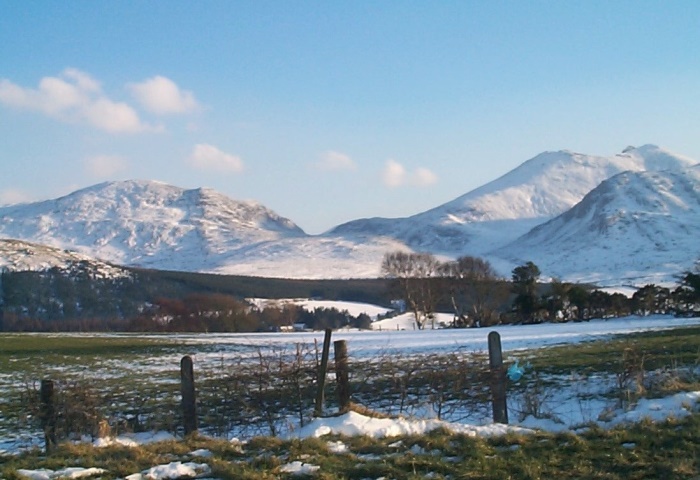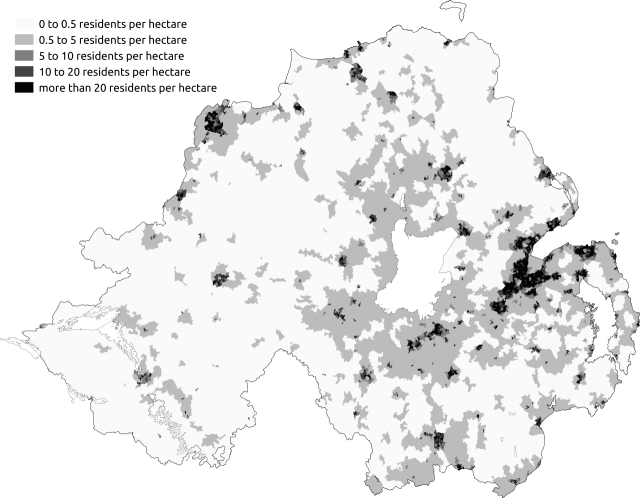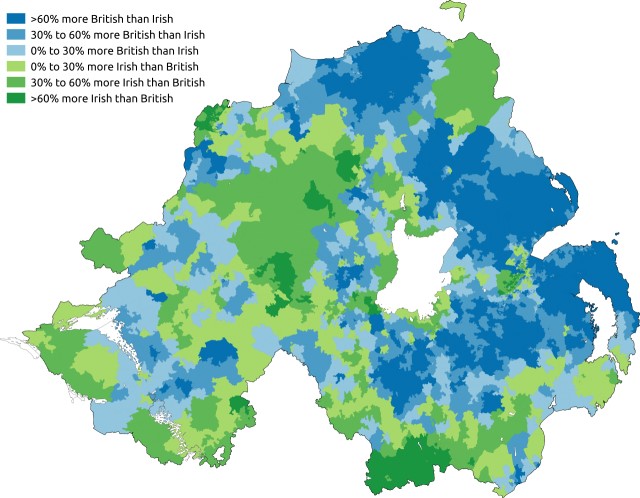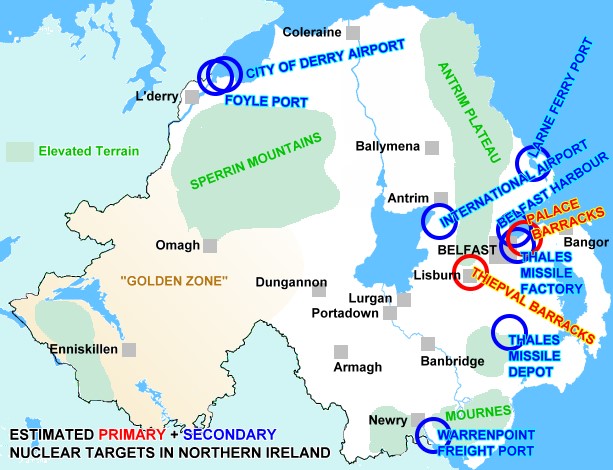Why a World-Famous Survivalist Author moved to Northern Ireland
Around 12 years ago, the renowned Argentinian preparedness
author
and YouTuber, Fernando “Ferfal” Aguirre,
was desperate to relocate from crime-ridden Buenos Aires to somewhere safe in western Europe.
He had a Spanish passport, which enabled him to live anywhere he wanted in the EU (which at the time included the UK), but first he had to find a location that met his special criteria of
(a) a low crime rate and (b) relaxed firearm laws, the latter being important to him because of his long-term participation in handgun training.
That location, he discovered, would be Northern Ireland:
Obviously, the land of "The Troubles” would not spring to mind as the first choice for any crime-weary survivalist
seeking a place of refuge.
After all, having experienced around a quarter of a century of internecine violence in which the Provisional IRA actively engaged the police, the British Army and Loyalist
paramilitaries (who in response undertook many kinetic reprisals themselves), Northern Ireland’s reputation was very much tarnished, a situation that did not simply change overnight with the
Good Friday Agreement in 1998 and ensuing ceasefires.
Since that time, however, paramilitary activity has died down and a new generation of young people has been born that knows nothing of what, to be frank, had been a low intensity civil war.
Naturally, sectarian tensions still exist, especially in the traditional interface areas in Belfast, but in other areas relations between the two communities are either amicable or mutually
tolerant (perhaps through gritted teeth!); for example, in spring the main street in the town of Lisnaskea in Fermanagh is bedecked in Irish tricolours from one end to the other,
yet in July it is Union Flags and red, white and blue bunting covering the same area.
Admittedly, dissident Republican
groups remain intact and still conduct targeting operations directed at the police, albeit they are miniscule in personnel and support,
so by no means is the situation anything close to the grave state it was in during the Troubles.
For the most part, people now are just getting on with living their lives and there is no high security forces presence any more, as attested to by the army
instantly mothballing its new delivery Airbus H135 helicopters in 2022,
citing the reason as the pacified situation in NI.
But what would make Northern Ireland suitable as a nuclear war retreat area for any concerned prepper today, in the present, pre-WW3 period?
To answer that, let's review the key criteria in turn.
Terrain, Geography & Demographics for Viable Retreat Country
The western part of Northern Ireland is dominated (a) by the Sperrins,
a low mountain range that is part of the Grampian geological zone stretching to the south west
from the Highlands of Scotland and (b) by the
Fermanagh Lakelands containing the Erne River
valley and the eponymous lakes there, which are a strong tourist attraction during summer months.
By the perception of most natives, Northern Ireland is divided into its eastern and western reaches by the
River Bann (hence phrases such as “east of the Bann”)
which rises in the Mourne Mountains to the far south east and flows into Lough Neagh in the middle of NI, before
exiting that large lake (the UK's biggest by surface area) and continuing northwards to the sea near Coleraine on the north coast.
The Mournes are the highest mountains in the northern half of the island of Ireland and are a continuation of Scotland’s
Southern Uplands
geological zone, albeit are higher than any part of the Scottish “parent” zone. The Isle of Man, southern Scotland, Snowdonia and the Wicklow Mountains south of Dublin are visible from
the Mournes.

The majority of Northern Ireland’s population is located east of the Bann (there’s that phrase again!), with most of its largest towns within the greater Belfast catchment area.
Belfast is, of course, the only real city in NI, despite the fact that Londonderry (or Derry, to the Republican majority populace there) is also formally a city,
as are the town-sized settlements of Armagh, Newry, Lisburn and Bangor, none of which are presently strategic targets, although in the past, Armagh was earmarked as one of
approximately a dozen "Regional Seats of Government (RSGs)" in the UK during the Cold War
and was deep bunkered accordingly, going from declassified revelations in
The Secret State, by Peter Hennessy (2010); however, Ballymena in Co. Antrim
has alternatively been cited as the Cold War's erstwhile RSG location for Northern Ireland.

While Irish Republicans in Northern Ireland still aspire to a United Ireland, they do not yet enjoy enough support to bring it about, and it is our assessment that despite their ongoing
declarations of bullish optimism, it is nowhere near happening; and with growing disillusionment amongst Irish nationalists with Sinn Féin's dalliance with the
globalists' open borders immigration agenda, the primary political party advocating for a United Ireland is haemorrhaging support.
Generally speaking, the Protestants of Northern Ireland tend to be more conservative and pro-UK than the Catholics; the former largely see themselves as beleaguered and somewhat betrayed
ethnic British people (being descendents, for the most part, of "Planters"
from lowland Scotland and northern & western England), whereas the latter mostly consider themselves as native Irish Celts
living in an artificial division from the rest of Ireland.

(Map of predominant national identity in the 2011 census in Northern Ireland, via Wikimedia Commons).
Like the rest of the UK, Northern Ireland has experienced substantial migration from outside the country, although unlike the mainland UK, most of this consists of
people from eastern Europe and Portugal, meaning it is relatively lacking in the
Islamist, African and southern Asian elements that abound in England, Wales and Scotland.
Nuclear War Retreat Considerations in Northern Ireland
Northern Ireland contains what we assess to be the best WW3 retreat geography within the UK in terms of minimising or
avoiding the risk of radioactive fallout, based on current projected strategic targets.
This is, obviously, due to (a) the fact that it has few potential nuclear targets itself and (b) is upwind of all mainland targets.

(Blast radii based on a 2 MT warhead detonation; all fallout from groundbursts projected to drift towards the east or north east).
Of the nuclear war targets it has, they are chiefly located in the greater Belfast area, with only three likely outliers
in the form of the commercial freight ports of Warrenpoint in the far SE of Northern Ireland and
Foyle Port near Londonderry, plus the
City of Derry Airport (in a bygone era, this was a dispersal airfield for the
V Bomber force),
all of which we expect would be secondary targets.
In fact, unless the MoD opens any new bases (or restores any closed ones), we think the only primary targets (i.e.
counterforce aka military targets) in Northern Ireland would be
(1) the MI5 HQ at
Palace Barracks on the eastern outskirts of Belfast,
and (2) the joint army and navy base at Thiepval Barracks in Lisburn,
on the south western edge of greater Belfast.
Additional secondary targets might consist of the power stations at Kilroot and
Ballylumford (both along the coast north of Belfast),
plus more probably the City Airport in east Belfast,
Belfast Harbour to the city's north,
Belfast International Airport at Aldergrove near the town of Antrim, to the north west of Belfast
(as it serves as a dispersal runway for Eurofighter Typhoons in the event of war with Russia), the ferry port at Larne, and the
Thales missile factory in east Belfast,
which manufactures the Starstreak, NLAW, Javelin and Hellfire missile systems, some of which are currently in use by Ukrainian forces fighting against the Russian invasion of their country. A related target
would be the Thales Missile storage depot near Annacloy in Co. Down.
However, the south west of Northern Ireland has no such targets, is far removed from projected blast radii, and is on the windward side (based on prevailing winds and weather patterns) of
all probable current primary and secondary targets in the region.
It also has a relatively low population density, smaller towns, plentiful rainfall (too much, the locals would say) and ready access via an open border to the Republic Of Ireland.
That latter point might not seem a plus at first glance, especially given the surge in social problems across the border,
but it provides the potential option of being able to drive to a fallback location in a neutral country, if only to a holiday cottage or modest apartment.
That said, the Republic of Ireland appears to be planning some very unwelcome laws concerning home ownership, covered under its
controversial Right to Housing Bill
that incorporates frankly tyrannical ideas about “down-sizing”, “right-sizing” and potentially regulating sales of dwellings on the basis of projected number of occupants,
for which reason (combined with its immigration-fuelled social problems and growing anti-outsider sentiment) it would seem to pose a greater risk as a retreat territory than Northern Ireland would.
Additional Nuclear War Targets as WW3 Nears / Defunct Cold War Targets?
None of the foregoing precludes the possibility of fresh potential targets emerging, including in safe areas, but this observation applies to any ostensibly safe area within or outside of
Northern Ireland.
For example, if the now defunct Cold War targets that were the disused army base at Ballykelly
(close to Limavady on the north coast) or the closed
St. Angelo Airport just north of Enniskillen in Co. Fermanagh were to be recommissioned,
that would notably alter the
target matrix in Northern Ireland, especially in the case of the latter hypothetical example.
Accordingly, we can only make emergency plans based on the best available current information, so for now, we stand by our assertion that the south west of Northern Ireland contains the UK's
best WW3 retreat-cum-strategic-relocation country.
The following is a partial list of known and rumoured Cold War targets that are now disused / overgrown / abandoned, presented here for the sake of countering misconceptions that some readers might
have about the present validity of those targets:
- Ballykelly army base (Co. Londonderry).
- St. Angelo Airport (Co. Fermanagh) - however, we recently spoke to a commercial helicopter pilot (who is an ex Army Air Corps Lynx pilot) who informed us that it is in no fit state for fixed wing operations.
- The US Navy transmitter in the Sperrin Mountains at Benbradagh near Dungiven (Co. Londonderry). There was also a rumour (unsubstantiated) that the US was storing nuclear munitions in deep bunkering at that now derelict site.
- RAF Bishops Court near Downpatrick (Co. Down).
- Woodside Industrial Estate in Ballymena, often cited as NI's Regional Seat of Government location duration the Cold War.
- Gough Barracks in Armagh, which had a nuclear bunker.
- St Lucia Barracks in Omagh, Co. Tyrone.
- Hillsborough in Co. Down, just south of Belfast, seat of the Royal Family in NI and site of the official residence of the Secretary of State for Northern Ireland.
Other Considerations: Low Crime Rate, Relaxed Gun Laws, Way of Life
Returning the criteria listed by Ferfal when selecting Northern Ireland as his landing pad in Europe back in 2012, i.e. low crime-rate and reasonable firearms regulations, nothing has changed
in the intervening years:
“statistics show that some places in Northern Ireland (outside of Belfast) have some of the lowest crime rates in Western Europe.” ~ Crime In Northern Ireland.
Rural areas in particular have very low crime rates, which is perhaps even more striking given that Northern Ireland, unlike much of the UK mainland,
has a long tradition of dispersed rural settlement, i.e., there are many detached homes dotted all over the countryside and that brings with it the natural effect of rural dwellers,
especially in “orange” (i.e. pro-UK) areas, being very conservative in their outlook.
Meanwhile, in contrast to the England and Wales, Northern Ireland's mains water supply is not fluoridated
(although, to be fair, neither is Scotland's).
Also unlike the UK mainland, handgun ownership is not just still permitted in Northern Ireland, but participated in by a large number of people.
Personal protection,
if successfully demonstrated to the police, is a permitted reason for owning one, with (going from my own acquaintances)
Glock products being a favourite, but semi-auto .22 rimfires are also allowed, along with shotguns.
Close to 6% of the population owns a firearm of some kind,
and I believe most of those would be rural dwellers.
Gun ownership laws might not be relevant to most people concerned primarily about WW3 survival planning, but it is an important topic for many conservative people with a preparedness
mindset and is thus mentioned herein.
Finally, for mainlanders wondering how different life in Northern Ireland is to the rest of the UK in terms of familiar shops, post office, the NHS, etc., it is pretty much identical
bar the presence of some retailers (i.e. Morrisons, Waitrose and Aldi), but most of them operate in the Province, including Tesco, Asda, Sainsburys (all of whom provide a home delivery service),
Marks & Spencer, Lidl, Halfords, KwikFit, Boots, B&Q, Homebase, Argos, Subway, MacDonalds, KFC, et al.
(NOTE: Unlike the mainland UK or across the border in the Republic of Ireland, the police in Northern Ireland always carry arms; usually
it will be a Glock 17 holstered, but sometimes you will see them with automatic rifles, even though there has been no civil conflict since the late 1990s. Off-duty police also tend to carry
a handgun. In a country with a high level of personal handgun ownership, this might not be unexpected).
Conclusion
Within the confines of the UK (if not Europe beyond), there is presently
no superior retreat locale for the avoidance of fallout from a nuclear strike in
a WW3 scenario than south western
Northern Ireland and, due to its low crime rate and lack of the many social problems plaguing the UK mainland and Republic of Ireland, NI is also worth considering as a “Plan B”,
if not a veritable “Plan A”, during the present antebellum period, as the world situation deteriorates towards the nuclear war that more and more concerned parties are now resigned to.
Should you be interested in acquiring a retreat property in Northern Ireland that meets the optimal survival criteria during a war with Russia, we provide a totally discreet and very
experienced property-finder service in the province (as well as in other regions of the UK).